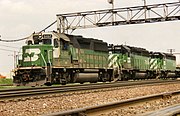Locomotive
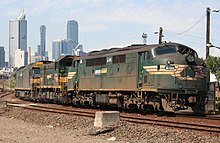
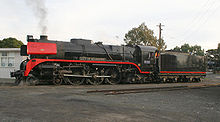

A locomotive is a railway vehicle that provides the motive power for a train. The word originates from the Latin loco – "from a place", ablative of locus, "place" + Medieval Latin motivus, "causing motion", and is a shortened form of the term locomotive engine,[1] first used in the early 19th century to distinguish between mobile and stationary steam engines.
A locomotive has no payload capacity of its own, and its sole purpose is to move the train along the tracks. In contrast, some trains have self-propelled payload-carrying vehicles. These are not normally considered locomotives, and may be referred to as multiple units, motor coaches or railcars. The use of these self-propelled vehicles is increasingly common for passenger trains, but rare for freight (see CargoSprinter). Vehicles which provide motive power to haul an unpowered train, but are not generally considered locomotives because they have payload space or are rarely detached from their trains, are known as power cars.
Traditionally, locomotives pull trains from the front. Increasingly common is push-pull operation, where a locomotive pulls the train in one direction and pushes it in the other, and can be controlled from a control cab at the other end of the train.
Origins
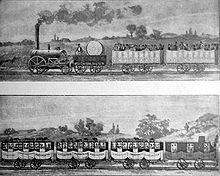
The first successful locomotives were built by Cornish inventor Richard Trevithick. In 1804 his unnamed steam locomotive hauled a train along the tramway of the Penydarren ironworks, near Merthyr Tydfil in Wales. Although the locomotive hauled a train of 10 tons of iron and 70 passengers in five wagons over nine miles (14 km), it was too heavy for the cast iron rails used at the time. The locomotive only ran three trips before it was abandoned. Trevithick built a series of locomotives after the Penydarren experiment, including one which ran at a colliery in Tyneside in northern England, where it was seen by the young George Stephenson.[2]
The first commercially successful steam locomotive was Matthew Murray's rack locomotive, Salamanca, built for the narrow gauge Middleton Railway in 1812. This was followed in 1813 by the Puffing Billy built by Christopher Blackett and William Hedley for the Wylam Colliery Railway, the first successful locomotive running by adhesion only. Puffing Billy is now on display in the Science Museum in London, the oldest locomotive in existence.[3]
In 1814 George Stephenson, inspired by the early locomotives of Trevithick and Hedley persuaded the manager of the Killingworth colliery where he worked to allow him to build a steam-powered machine. He built the Blücher, one of the first successful flanged-wheel adhesion locomotives. Stephenson played a pivotal role in the development and widespread adoption of steam locomotives. His designs improved on the work of the pioneers. In 1825 he built the Locomotion for the Stockton and Darlington Railway, north east England, which became the first public steam railway. In 1829 he built The Rocket which was entered in and won the Rainhill Trials. This success led to Stephenson establishing his company as the pre-eminent builder of steam locomotives used on railways in the United Kingdom, the United States and much of Europe.[4] The first inter city passenger railway, Liverpool and Manchester Railway, opened in 1830, making exclusive use of steam power for both passenger and freight trains.
Locomotives vs. multiple units
This article reads like a textbook. (April 2009) |
Advantages of locomotives

There are many reasons why the motive power for trains has been traditionally isolated in a locomotive, rather than in self-propelled vehicles.[5]
- Ease
- Should the locomotive fail, it is easy to replace it with another. Failure or maintenance of the motive power unit does not require taking the entire train out of service.
- Maximum utilization of power cars
- Idle trains waste costly motive power resources. Separate locomotives enable costly motive power assets to be moved around as needed.
- Flexibility
- Large locomotives can be substituted for small locomotives where the grades are steeper and more power is needed. A 'passenger' locomotive can also be used for freight duties if needed, and vice versa.
- Obsolescence cycles
- Separating the motive power from payload-hauling cars enables one to be replaced without affecting the other. At times locomotives have become obsolete when their cars were not, and vice versa.
- Safety
- In case of an accident, the locomotive may act as buffer zone for the rest of the train. If an obstacle is encountered on the line, the heavier mass of a locomotive is less likely to be deviated from its normal course. Also it may be safer in the event of fire especially with diesel locomotives.
- Noise
- A single source of tractive power, which means only motors in one place, means that the train will be quieter than with multiple unit operation, where one or more motors are located under every carriage. The noise problem is particularly present in diesel multiple units.
Advantages of multiple units
There are several advantages of multiple unit (MU) trains compared to locomotives.
- Energy efficiency
- Multiple units are more energy efficient than locomotive-hauled trains and more nimble, especially on grades, as much more of the train's weight (sometimes all of it) is placed on driven wheels, rather than suffer the dead weight of unpowered coaches.
- No need to turn locomotive
- Many multiple units have cabs at both ends , the train may be reversed without uncoupling/re-coupling the locomotive, giving quicker turnaround times, reducing crew costs, and enhancing safety. In practice, the development of driving van trailers and cab cars has removed the need for locomotives to run-around, giving easy bi-directional working and removing this MU advantage.
- Reliability
- As multiple unit trains have multiple engines, the failure of one engine does not prevent the train from continuing its journey. A locomotive drawn passenger train typically only has one power unit, meaning the failure of this causes the train to be disabled. However, some locomotive hauled passenger trains may utilize more than one locomotive, as do many locomotive hauled freight trains, and so are able to continue at reduced speed after the failure of one locomotive.
- Safety
- Multiple units normally have completely independent braking systems on all cars, meaning the failure of the brakes on one car does not prevent the brakes throughout the train from operating safely.
Locomotive classifications
Motive power
Locomotives may generate their power from fuel (wood, coal, petroleum or natural gas), or they may take power from an outside source of electricity. It is common to classify locomotives by their source of energy. The common ones include:
Steam


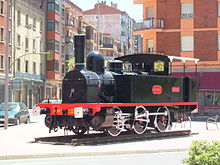
In the 19th century the first railway locomotives were powered by steam, usually generated by burning coal. Because steam locomotives included one or more steam engines, they are sometimes referred to as "steam engines". The steam locomotive remained by far the most common type of locomotive until after World War II.[6]
The first steam locomotive was built by Richard Trevithick; it first ran on 21 February 1804, although it was some years before steam locomotive design became economically practical.[2]. The first commercial use of a steam locomotive was The Salamanca on the narrow gauge Middleton Railway in Leeds in 1812. The locomotive Fairy Queen, built in 1855 runs between Delhi and Alwar in India and is the oldest steam locomotive in regular (albeit tourist-only) service in the world, and the oldest steam locomotive operating on a mainline.[7][8]
The all-time speed record for steam trains is held by an LNER Class A4 4-6-2 Pacific locomotive of the LNER in the United Kingdom, number 4468 Mallard, which pulling six carriages (plus a dynamometer car) reached 126 mph (203 km/h) on a slight downhill gradient down Stoke Bank on 3 July 1938.[9] Aerodynamic passenger locomotives in Germany attained speeds very close to this and due to the difficulties of adequately balancing and lubricating the running gear, this is generally thought to be close to the practicable limit for a direct-coupled steam locomotive.[10]
Before the middle of the 20th century, electric and diesel-electric locomotives began replacing steam locomotives. Steam locomotives are less efficient than their more modern diesel and electric counterparts and require much greater manpower to operate and service.[11] British Rail figures showed the cost of crewing and fuelling a steam locomotive was some two and a half times that of diesel power, and the daily mileage achievable was far lower. As labour costs rose, particularly after the second world war, non-steam technologies became much more cost-efficient.[citation needed] By the end of the 1960s-1970s, most western countries had completely replaced steam locomotives in passenger service. Freight locomotives generally were replaced later. Other designs, such as locomotives powered by gas turbines, have been experimented with, but have seen little use, mainly due to high fuel costs.
By the end of the 20th century, almost the only steam power still in regular use in North America and Western European countries was on heritage railways largely aimed at tourists and/or railroad hobbyists, known as 'railfans' or 'railway enthusiasts', although some narrow gauge lines in Germany which form part of the public transport system, running to all-year-round timetables retain steam for all or part of their motive power. Steam locomotives remained in commercial use in parts of Mexico into the late 1970s. Steam locomotives were in regular use until 2004 in the People's Republic of China, where coal is a much more abundant resource than petroleum for diesel fuel. India switched over from steam-powered trains to electric and diesel-powered trains in the 1980s, except heritage trains. In some mountainous and high altitude rail lines, steam engines remain in use because they are less affected by reduced air pressure than diesel engines.[citation needed] Steam locomotives remained in routine passenger use in South Africa until the late 1990s, but are now reserved to tourist trains. In Zimbabwe steam locomotives are still used on shunting duties around Bulawayo and on some regular freight services.
As of 2006 DLM AG (Switzerland) continues to manufacture new steam locomotives.[12]
Gasoline
Gasoline locomotives have been produced since the early 1900s.[13][14]
Diesel

Experimental diesel-powered locomotives were first built just after World War I. In the 1940s, they began to displace steam power on American railroads. Following the end of World War II, diesel power began to appear on railroads in many countries. In many countries the significantly better economics of diesel operation triggered a dash to diesel power, a process known as Dieselization. By the late 1960s, few major railroads in North America, Europe and Oceania continued to operate steam locomotives, although significant numbers still existed outside these areas.
As is the case with any vehicle powered by an internal combustion engine, diesel locomotives require some type of power transmission system to couple the output of the prime mover to the driving wheels. In the early days of diesel railroad propulsion development, electric, hydraulic and mechanical power transmission systems were all employed with varying degrees of success. Of the three, electric transmission has proved to be most popular, and although diesel-hydraulic locomotives have certain advantages and are continuously used in some European countries, most modern Diesel-powered locomotives are diesel-electric.
Diesel locomotives require considerably less maintenance than steam, with a corresponding reduction in the number of personnel needed to keep the fleet in service. The best steam locomotives spent an average of three to five days per month in the shop for routine maintenance and running repairs.[citation needed] Heavy overhauls were frequent, often involving removal of the boiler from the frame for major repairs. In contrast, a typical diesel locomotive requires no more than eight to ten hours of maintenance per month.[citation needed] and may run for many years between heavy overhauls.[citation needed]
Diesel units are not as polluting as steam power;[citation needed] modern units produce low levels of exhaust emissions. Diesel-electric locomotives are often fitted with "dynamic brakes" that use the traction motors as electrical generators during braking to assist in controlling the speed of a train on a descending grade. This technology is similar to regenerative braking used in hybrid cars, the key difference being that dynamic braking does not store the generated power, instead routing it to resistors where it is converted into waste heat.
Electric

In 1893 in Paris Charles Brown assisted Jean Heilmann in evaluating AC and DC transmission systems for "Fusée Electrique", a steam locomotive with electric transmission, and using this knowledge he designed a three-phase AC electric locomotive for Oerlikon, Zurich. Brown (by then in partnership with Walter Boveri) put these into service on the first electrified main line, the Burgdorf—Thun line, Switzerland, in 1899. Each thirty-tonne locomotive had two 150 h.p. motors.[16]
In 1894, a Hungarian engineer Kálmán Kandó developed high-voltage three phase alternating current motors and generators for electric locomotives.[17] His work on railway electrification was done at the Ganz electric works in Budapest. The first installation was on the Valtellina line, Italy, in 1902. Kandó was the first who recognised that an electric train system can only be successful if it can use the electricity from public networks. After realising that, he also provided the means to build such a rail network by inventing a rotary phase converter suitable for locomotive usage.
The electric locomotive is supplied externally with electric power, either through an overhead pickup or through a third rail. While the capital cost of electrifying track is high, electric trains and locomotives are capable of higher performance and lower operational costs than steam or diesel power.[citation needed] Electric locomotives, because they tend to be less technically complex than diesel-electric locomotives, are both easier and cheaper to maintain and have extremely long working lives, usually 40 to 50 years[citation needed] – there are many examples of electric locomotives operating for more than half a century with minimal overhaul, and it is not unusual for electric locomotives to be operating close to their centenary.[citation needed] The Finnish State Railroad is planning to phase out the Soviet-manufactured VR Class Sr1 engines, operative since 1973, in 2024, at which time they will have been over fifty years in line service.
A French TGV holds the world speed record for the fastest wheeled train, having reached 574.8 km/h (357 mph) on 3 April 2007.[18][19]
Some electric locomotives can also operate off battery power to enable short journeys or shunting on non-electrified lines or yards.[citation needed] Battery-powered locomotives are used in mines and other underground locations where diesel fumes or smoke would endanger crews, and where external electricity supplies cannot be used due to the danger of sparks igniting flammable gas.[citation needed] Battery locomotives are also used on many underground railways for maintenance operations, as they are required when operating in areas where the electricity supply has been temporarily disconnected.[citation needed]
Hybrids
The main reason why hybrid locomotives have been invented is because this eliminates the need for a mechanical transmission. Otherwise, a gearbox would be needed which is large, complicated and inefficient.[20] A hybrid locomotive allows the internal combustion engine to run at a constant speed, turning an electrical generator which in turn powers an electrical engine.
Several types of internal combustion engine (ICE)-electric hybrids exist, including gasoline-electric, diesel-electric, and Gas turbine-electric
In addition, there are also fuel-cell-electric locomotives, forming a category on their own.[21]
Besides hybrid locomotives which use only a fuelled power source (i.e. internal combustion engine, and a electrical engine [22], there are also hybrids that use a fuelled power source, battery and electrical engine. Here, the battery acts as a temporary energy store, allowing e.g. the implementation of regenerative braking and switching off the hydrocarbon engine when idling or stationary (as used in automobiles such as the Toyota Prius). Steam-diesel hybrid locomotives have been tried in Britain, Russia and Italy but with only limited success.
Gas turbine-electric
A gas turbine-electric locomotive, or GTEL, is a locomotive that uses a gas turbine to drive an electrical generator or alternator. The electric current thus produced is used to power traction motors. This type of locomotive was first experimented with in 1920 but reached its peak in the 1950s to 1960s. The turbine (similar to a turboshaft engine) drives an output shaft, which drives the alternator via a system of gears.
A turbine offers some advantages over a piston engine.[citation needed] The number of moving parts is much smaller, and the power to weight ratio is much higher. A turbine of a given power output is also physically smaller than an equally powerful piston engine, allowing a locomotive to be very powerful without being inordinately large. However, a turbine's power output and efficiency both drop dramatically with rotational speed, unlike a piston engine, which has a comparatively flat power curve.
Gas turbine locomotives are very powerful, but also tend to be very loud. Union Pacific Railroad operated the largest fleet of gas turbine-electric locomotives in the world, and was the only railroad to use them for hauling freight in regular service. Most other GTELs have been built for small passenger trains, and only a few have seen any real success in that role.
After the 1973 oil crisis and the subsequent rise in fuel costs, gas turbine locomotives became uneconomical to operate, and many were taken out of service. This type of locomotive is now rare.
Fuel cell-electric
In 2002 the first 3.6 tonne, 17 kW hydrogen (fuel cell)-powered mining locomotive was demonstrated in Val-d'Or, Quebec. In 2007 the educational mini-hydrail in Kaohsiung, Taiwan went into service. The Railpower GG20B finally is another example of a fuel cel-electric locomotive.
Slug or Drone
A slug or drone locomotive is a non-powered unit attached to a diesel-electric locomotive to provide additional traction and braking capability. The slug has traction motors but no engine, power being supplied by the attached locomotive (known as a 'mother'). At slow speeds, a diesel-electric prime mover can potentially produce more power than can be usefully used by its own traction motors; a slug increases the number of traction motors available to use the power more effectively.
Slugs are mainly used in rail yards for switching duties, in which case they are normally built without a cab. Other slugs, designed for use on service trains, may be fitted with a cab, which can control the whole consist, and may also provide additional fuel storage for the mother locomotive. In recent years, conventional locomotives have been used in place of slugs on service trains, remotely controlled from the lead locomotive configuration.
CP Rail used a prototype drone locomotive system called LOCOTROL which evolved into today's systems.
Use

The three main categories of locomotives are often subdivided in their usage in rail transport operations. There are passenger locomotives, freight locomotives and switcher (or shunting) locomotives. These categories determine the locomotive's combination of physical size, starting tractive effort and maximum permitted speed. Freight locomotives are normally designed to deliver high starting tractive effort—needed to start trains that may weigh as much as 15,000 tons—and deliver sustained high power, at the sacrifice of maximum speed. Passenger locomotives develop less starting tractive effort but are able to operate at the high speeds demanded by passenger schedules. Mixed traffic locomotives (US English: general purpose or road switcher locomotives) are built to provide elements of both requirements. They do not develop as much starting tractive effort as a freight unit but are able to haul heavier trains than a passenger engine.
Most steam locomotives are reciprocating units, in which the pistons are coupled to the drivers (driving wheels) by means of connecting rods. Therefore, the combination of starting tractive effort and maximum speed is greatly influenced by the diameter of the drivers. Steam locomotives intended for freight service generally have relatively small diameter drivers, whereas passenger models have large diameter drivers (as large as 84 inches in some cases).
With diesel-electric and electric locomotives, the gear ratio between the traction motors and axles is what adapts the unit to freight or passenger service, although a passenger unit may include other features, such as head end power (also referred to as hotel power or electric train supply) or a steam generator.
Some locomotives are designed specifically to work mountain railways, and feature extensive additional braking mechanisms and sometimes rack and pinion. Steam locomotives built for steep rack and pinion railways frequently have the boiler tilted relative to the wheels, so that the boiler remains roughly level on steep grades.
Wheel arrangement
Wheel arrangement is one type of classification. Common methods include the AAR wheel arrangement, UIC classification, and Whyte notation systems.
Remote control locomotives
In the second half of the twentieth century remote control locomotives started to enter service in switching operations, being remotely controlled by an operator outside of the locomotive cab.
Locomotives in numismatics
Locomotives have been a subject for collectors' coins and medals. One of the most famous and recent ones is the 25 euro 150 Years Semmering Alpine Railway commemorative coin. The obverse shows two locomotives: a historical and a modern one. This represents the technical development in locomotive construction between the years 1854 and 2004. The upper half depicts the “Taurus”, a high performance locomotive. Below is shown the first functional Alpine locomotive, the Engerth; constructed by Wilhelm Freiherr von Engerth.
Gallery
| Part of a series on |
| Rail transport |
|---|
 |
|
|
| Infrastructure |
|
|
| Service and rolling stock |
|
| Special systems |
|
|
| Miscellanea |
|
|
- Locomotives
-
Steam locomotive B-5112 in Ambarawa Railway Museum - Indonesia
-
WDM-3A diesel passenger and freight locomotive of Indian Railways at Shantiniketan, India
-
Spanish Modern electric locomotive TALGO-BOMBARDIER, with 8,000 KW of power and 330 Km/h (205 mph) maximum speed
-
EMD GP50 diesel-electric freight locomotive of the Burlington Northern Railroad
-
Swiss Electric Locomotive at Brig, Switzerland, note the Alps at top right corner.
See also
References
- ^ ""Locomotive"". (etymology). Online Etymology Dictionary. Retrieved 2008-06-02.
- ^ a b Hamilton Ellis (1968). The Pictorial Encyclopedia of Railways. The Hamlyn Publishing Group. p. 12.
- ^ Hamilton Ellis (1968). The Pictorial Encyclopedia of Railways. The Hamlyn Publishing Group. pp. 20–22.
- ^ Hamilton Ellis (1968). The Pictorial Encyclopedia of Railways. The Hamlyn Publishing Group. pp. 24–30.
- ^ "Comparison of locomotive hauled and multiple unit trains".
- ^ Hamilton Ellis (1968). The Pictorial Encyclopedia of Railways. The Hamlyn Publishing Group. p. 355.
- ^ "National Railway Museum of India article on Fairy Queen".
- ^ "History Wired article on John Bull".
- ^ "LNER Encyclopedia article on the Gresley A4".
- ^ "Deutsche Bahn Museum article on the 05 001 locomotive".
- ^ "1935 article on the advantages of diesel locomotives".
- ^ DLM AG website
- ^ Gasoline locomotives TIME article
- ^ Direct drive gasoline locomotives
- ^ Duffy, Michael C. (2003). Electric railways, 1880-1990. Stevenage, England: Institution of Electrical Engineers. p. 40. ISBN 0-85296-805-1.
- ^ Duffy (2003: 117)
- ^ Hungarian Patent Office. "Kálmán Kandó (1869 - 1931)". www.mszh.hu. Retrieved 2008-08-10.
- ^ Associated Press (2007-04-04). "French train breaks speed record". cnn.com. CNN. Archived from the original on 2007-04-07. Retrieved 2008-01-10.
- ^ Fouquet, Helene and Viscousi, Gregory (2007-04-03). "French TGV Sets Record, Reaching 357 Miles an Hour (Update2)". Bloomberg. Retrieved 2007-09-19.
{{cite news}}: CS1 maint: multiple names: authors list (link) - ^ Hybrid locomotives invented to eliminate need of mechanical transmission
- ^ Gasoline-hybrid locomotive built in 1913
- ^ Batteries being generally used only to start ICE-engine, not as buffer
External links
- An engineer's guide from 1891
- Animated engines, Steam Locomotive
- International Steam Locomotives
- Turning a Locomotive into a Stationary Engine, Popular Science monthly, February 1919, page 72, Scanned by Google Books: http://books.google.com/books?id=7igDAAAAMBAJ&pg=PA72




